
 |
||||||||||||||||||
Falconry is basically the pursuit of game with a trained raptor.
Falconry has been around for 4000 years.
Its history has been traced as far back as 2000 B.C. through ancient writings,
artifacts, and art. It 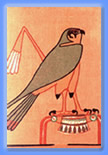 developed
in the ancient civilizations of the Middle East, Asia, and Europe.
developed
in the ancient civilizations of the Middle East, Asia, and Europe.
The ancient Egyptians worshiped a falcon god called Horus and trained raptors on perches are depicted in Egyptian art.
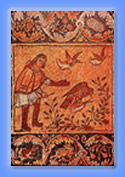 By
the second century A.D. falconry had spread into Asia and by the fourth century into Europe. Most people's knowledge of falconry stems from its popularity
in medieval Europe and the middle east during the middle ages. It sometimes
is called the "sport of kings" because of its association with the
ruling classes and royalty of these early societies. With the advent of gunpowder
and firearms in the 17th Century falconry as a means of obtaining food died
out. In the early 1900's falconry was reborn in the U.S. and Europe and its
popularity has been increasing ever since.
By
the second century A.D. falconry had spread into Asia and by the fourth century into Europe. Most people's knowledge of falconry stems from its popularity
in medieval Europe and the middle east during the middle ages. It sometimes
is called the "sport of kings" because of its association with the
ruling classes and royalty of these early societies. With the advent of gunpowder
and firearms in the 17th Century falconry as a means of obtaining food died
out. In the early 1900's falconry was reborn in the U.S. and Europe and its
popularity has been increasing ever since.
Though some of the equipment has been moderized, the basic method of training a hawk for falconry has not changed since the early days. The general philosophy is to condition the hawk to accept the falconer as a partner in the hunting process while maintaining its natural physical condition and hunting instincts. Training is accomplished through careful weight management, positive reinforcement, and repetition.
The first step in training entails a period
known as "manning". It is during this time that the hawk begins to
overcome its fear of people, becomes accustomed to the falconer, and learns
to associate food with the falconer's glove. During the first few days of manning,
the falconer spends many hours with the hawk. Once the hawk overcomes its initial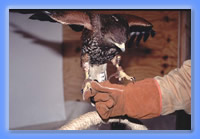 fear of the falconer it begins to accept food rewards that are placed on the falconer's glover.
Once this occurs, the hawk is encouraged
to step up onto the glove for food rewards. As the training progresses, the
hawk will be encouraged to hop, jump, and eventuallly fly increasingly greater
distances to the falconer. In just a couple weeks the hawk is flying to the
falconer on a light line called a creance.
At this stage the hawk is introduced to a lure that has some resemblence to
the intended game and is garnished with food. The hawk is taught that whenever
it comes to this lure it will receive a significant food reward.
fear of the falconer it begins to accept food rewards that are placed on the falconer's glover.
Once this occurs, the hawk is encouraged
to step up onto the glove for food rewards. As the training progresses, the
hawk will be encouraged to hop, jump, and eventuallly fly increasingly greater
distances to the falconer. In just a couple weeks the hawk is flying to the
falconer on a light line called a creance.
At this stage the hawk is introduced to a lure that has some resemblence to
the intended game and is garnished with food. The hawk is taught that whenever
it comes to this lure it will receive a significant food reward.
After roughly 3 to 4 weeks of training the
hawk is ready to fly completely free to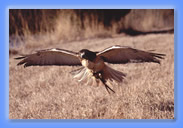 pursue wild game with the falconer. This process of initially releasing a hawk
to hunt a certain type of quarry is called entering. For many falconers this
is the most trying time as it is at this stage that the hawk is most likely
to fly away and revert to the wild. It is for this reason that it is important
to release the hawk at a site where game is plentiful and the hunting instincts
of the bird will prevail. If all goes well, the falconer and possibly his hunting
dog will flush game that the hawk can chase, kill, and eat.
pursue wild game with the falconer. This process of initially releasing a hawk
to hunt a certain type of quarry is called entering. For many falconers this
is the most trying time as it is at this stage that the hawk is most likely
to fly away and revert to the wild. It is for this reason that it is important
to release the hawk at a site where game is plentiful and the hunting instincts
of the bird will prevail. If all goes well, the falconer and possibly his hunting
dog will flush game that the hawk can chase, kill, and eat.
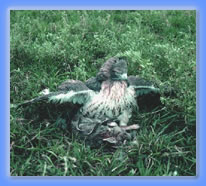 Once
the hawk has eaten its fill, the falconer approaches and coaxes the hawk up
onto the glove with a food reward. When this occurs the hawk associates the
event and the meal with the presence of the falconer and sets the stage for
the hawk to repeat the same behavior on the next hunt. The bond between the
hawk and the falconer increases with continued hunting and time together. Forging
this relationship with a wild raptor is what falconry is all about.
Once
the hawk has eaten its fill, the falconer approaches and coaxes the hawk up
onto the glove with a food reward. When this occurs the hawk associates the
event and the meal with the presence of the falconer and sets the stage for
the hawk to repeat the same behavior on the next hunt. The bond between the
hawk and the falconer increases with continued hunting and time together. Forging
this relationship with a wild raptor is what falconry is all about.
Falconry represents a unique relationship between a human and a wild animal. The falconer's commitment to the hawk is deep. He (or she) must serve the hawk's every need in terms of providing food, shelter, exercise, chances to hunt, and health care. The free-flying hawk has many opportunities to simply fly away and return to the wild. However, in most cases the hawk recognizes its bond to its human partner and voluntarily returns time after time to the falconer's glove and the care he provides.
Website copyright Ohio Falconry Association,
2001, All rights reserved.
Send website comments to the webmaster
Send comments and questions about OFA to info@ohiofalconry.org